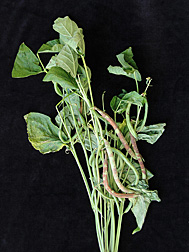Washington, DC
August 11, 2009
Agricultural Research Service, USDA
By Jan
Suszkiw
 |
|
Snap
bean pods showing symptoms of chocolate pod, a disease
that causes unsightly defects, such as discoloration and
curling, rendering the beans unsuitable for fresh,
frozen, and canning markets. |
New, virus-resistant snap beans
could soon be on tap, thanks to genetic sleuthing by
Agricultural Research Service
(ARS) scientists in Prosser, Wash.
The target of their
investigation, a strain of the clover yellow vein virus, is the
culprit behind chocolate pod, a disease that causes unsightly
defects on snap bean pods, ruining their marketability.
Soybean aphids transmit the
virus while feeding on bean plants, but spraying insecticide to
prevent such feeding isn't always effective or economically
feasible. Incorporating genes for resistance into the crop
offers a better approach, according ARS plant pathologist
Richard Larsen.
Toward that end, he and ARS
geneticist
Phil Miklas developed a polymerase chain reaction
(PCR)-based test for detecting the chocolate pod virus and
distinguishing it from other bean pathogens.
They were able to do so by
identifying the sequence of amino acids that make up the virus'
coat protein, explains Larsen, who, along with Miklas, works in
the ARS
Vegetable and Forage Crops Research Laboratory at Prosser.
The research was published in the journal
Plant Disease.
The test, which yields results
in less than a day versus weeks by traditional methods, has
become a critical screening tool in the search for resistant
bean germplasm. Only one snap bean variety out of 63 the
researchers screened showed some resistance to chocolate pod.
Fortunately, a gene found in
dry edible beans conferred stronger resistance. Even better, the
gene "coexists" with another, dubbed bc-3, which confers
resistance to other bean pathogens, including bean common mosaic
virus and bean yellow mosaic virus.
Larsen and Miklas plan on
crossing the resistant dry beans with the susceptible snap beans
so that they, too, will reap the benefits of possessing multiple
virus-resistance genes. Commercial cultivars developed from such
crosses will be especially important for snap bean farmers in
Wisconsin, Michigan and other Great Lakes states, where the
first outbreak of chocolate pod occurred in 2001.
Read more about this research in the August 2009 issue of
Agricultural Research magazine.
ARS is the principal
intramural scientific research agency of the
U.S.
Department of Agriculture.
Nuevas variedades de judías
verdes que tienen resistencia a un virus pronto podrían estar
disponibles, gracias a las investigaciones de algunos
científicos del
Servicio de Investigación Agrícola (ARS) en Prosser,
Washington.
El objetivo de su
investigación–una cepa del virus del amarilleamiento de las
venas del trébol–es el culpable de la vaina de chocolate, la
cual es una enfermedad que causa defectos feos en las vainas de
las judías verdes, estropeando su potencial de venta.
Los áfidos de la soya
transmiten el virus cuando se alimentan de las plantas de
judías, pero fumigar las plantas con insecticidas para prevenir
esta alimentación no siempre es eficaz o económicamente viable.
Incorporar genes de resistencia en el cultivo ofrece un mejor
enfoque, según patólogo de plantas
Richard Larsen con el ARS.
Larsen y genetista
Phil Miklas con el ARS desarrollaron una prueba basada en la
reacción en cadena de la polimerasa para detectar el virus de la
vaina de chocolate y distinguir entre ese virus y otros
patógenos de judías. Ellos pudieron hacerlo identificando la
secuencia de aminoácidos que forman la proteína de superficie
del virus. Larsen y Miklas trabajan en el
Laboratorio de Investigación de Cultivos Vegetales y Forraje
mantenido por el ARS en Prosser. Los resultados de la
investigación fueron publicados en la revista 'Plant
Disease' (Enfermedades de Plantas).
La prueba, la cual rinde
resultados en menos de un día a diferencia de las semanas
requeridas para los métodos tradicionales, ha llegado a ser una
herramienta esencial de evaluación en la búsqueda para el
germoplasma de judía que tiene resistencia al virus. Sólo una
variedad de judía verde, entre las 63 variedades probadas,
demostró alguna resistencia a la vaina de chocolate.
Afortunadamente, un gen encontrado en las judías secas
comestibles proveyó una resistencia más fuerte. Aún mejor, ese
gen "coexiste" con otro gen, nombrado bc-3, que provee
resistencia a otros patógenos de judía, incluyendo el virus del
mosaico común de la judía y el virus del mosaico amarillo de la
judía.
Larsen y Miklas planean cruzar
las judías secas resistentes con las judías verdes susceptibles
para que las nuevas variedades puedan cosechar los beneficios de
poseer múltiples genes de resistencia a los virus.
Los cultivares comerciales
desarrollados de tales cruces serán especialmente importantes
para los granjeros de judías verdes en Wisconsin, Michigan y
otros estados de la región de los Grandes Lagos de EE.UU., donde
el primer brote de la vaina de chocolate ocurrió en el año 2001.
Lea más sobre esta investigación en la revista 'Agricultural
Research' de agosto del 2009.
ARS es la agencia principal
de investigaciones científicas del
Departamento de Agricultura de EE.UU. |